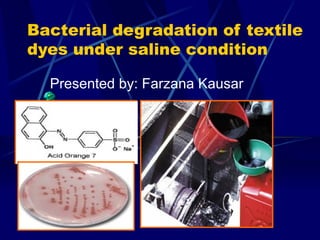F A R Z A N A
•Download as PPT, PDF•
6 likes•1,192 views
presentation to prepare
Report
Share
Report
Share

Recommended
More Related Content
Viewers also liked
Viewers also liked (13)
Synthesis of polymer supported nanoscale zerovalent iron and its

Synthesis of polymer supported nanoscale zerovalent iron and its
adsorption of methylene blue onto xanthogenated modified chitosan microbeads

adsorption of methylene blue onto xanthogenated modified chitosan microbeads
Dye removal from waste water by using low cost adsorbent: A review 

Dye removal from waste water by using low cost adsorbent: A review
Dye removal by adsorption on waste biomass - sugarcane bagasse

Dye removal by adsorption on waste biomass - sugarcane bagasse
Similar to F A R Z A N A
Similar to F A R Z A N A (8)
EFFECTS OF SALINITY ON SEED GERMINATION AND SEEDLING DEVELOPMENT OF TOMATO ...

EFFECTS OF SALINITY ON SEED GERMINATION AND SEEDLING DEVELOPMENT OF TOMATO ...
Synthesis And Evaluation of Different Numbers of Phosphonate Group Containing...

Synthesis And Evaluation of Different Numbers of Phosphonate Group Containing...
F A R Z A N A
- 1. Bacterial degradation of textile dyes under saline condition Presented by: Farzana Kausar
- 9. Table 1: Isolation of salt tolerant bacterial strains S-1 S-2 S-3 S-4 S-5 S-6 S-7 S-8 S-9 S-10 T-1 T-19 T-2 T-20 T-3 T-21 T-4 T-22 T-5 T-23 T-6 T-24 T-7 T-8 T-9 T-10 T-11 T-12 T-13 T-14 T-15 T-16 T-17 T-18 F-1 F-19 F-2 F-20 F-3 F-4 F-5 F-6 F-7 F-8 F-9 F-10 F-11 F-12 F-13 F-14 F-15 F-16 F-17 F-18 KS-1 KS1-19 KS-2 KS-20 KS-3 KS-21 KS-4 KS-22 KS-5 KS-23 KS-6 KS-24 KS-7 KS-25 KS-8 KS-26 KS-9 KS-27 KS-10 KS-28 KS-11 KS-29 KS-12 KS30 KS-13 KS-14 KS-15 KS-16 KS-17 KS-18 KW-1 KW-2 KW-3 KW-4 KW-5 KW-6 KW-7 KW-8 KW-9 KW-10 KW-11 KW-12 KW-13 KW-14 KW-15 KW-16 KW-17 KW-18 Saline soil of khewra salt mines Qazaffi textile mill Noshad textile mill Ocean sludge Ocean water Khewra Faisalabad Karachi
- 13. Table 2: The selected strains of bacteria capable of degrading azo dye at 50 g NaCl l - 80 S-4 70 F-9 90 T-17 100 T-14 100 KS-26 100 KS-23 % Decolorization Bacterial Strains
- 14. DEGRADATION OF REACTIVE BLACK-5 All the three strains of bacteria were able to decolorize Reactive Black-5 up to salt concentration of 60 g NaCl l -1 . The degradation rate was affected with increase in salt concentration
- 15. Fig. 1: Potential of bacterial strain KS-23 for decolorization of Reactive Black-5 at different salt concentration (0-60 g NaCl l -1 )
- 16. Fig. 2: Potential of bacterial strain KS-26 for decolorization of Reactive Black-5 at different salt concentration (0-60 g NaCl l -1 )
- 17. Fig. 3: Potential of bacterial strain T-14 for decolorization of Reactive Black-5 at different salt concentration (0-60 g NaCl l -1 )
- 18. DEGRADATION OF REACTIVE BLUE BRS All the selected strains were able to degrade Reactive Blue BRS efficiently. Bacterial strains were able to tolerate salt concentration up to 100 g NaCl l -1 .
- 19. Fig. 4: Potential of bacterial strain KS-23 for decolorization Reactive Blue BRS at different salt concentration (0-100 g NaCl l -1 )
- 20. Fig. 5: Potential of bacterial strain KS-26 for decolorization Reactive Blue BRS at different salt concentration (0-100 g NaCl l -1 )
- 21. Fig. 6: Potential of bacterial strain T-14 for decolorization Reactive Blue BRS at different salt concentration (0-100 g NaCl l -1 )
- 22. DEGRADATION OF REACTIVE GOLDEN OVIFIX Bacterial strains were able to decolorize Reactive Golden Ovifix. All the three strains were able to decolorize Reactive Golden Ovifix in the presence of salt concentration 0-60 g NaCl l -1 .
- 23. Fig. 7: Potential of bacterial strain KS-23 for decolorization Reactive Golden Ovifix at different salt concentration (0-100 g NaCl l -1 )
- 24. Fig. 8: Potential of bacterial strain KS-26 for decolorization Reactive Golden Ovifix at different salt concentration (0-100 g NaCl l -1 )
- 25. Fig. 9: Potential of bacterial strain T-14 for decolorization Reactive Golden Ovifix at different salt concentration (0-100 g NaCl l -1 )
- 26. CONCLUSION This research suggested that under high saline conditions microbial activity is affected but there are many bacteria that have natural ability to tolerate such saline conditions. Therefore use of such halotolerant bacteria can be useful for the degradation of azo dyes under saline conditions.
